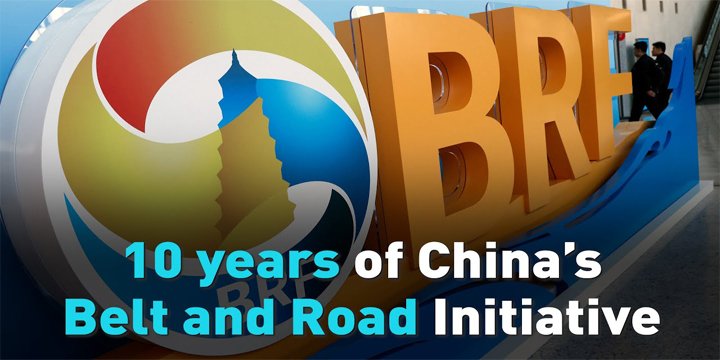10 years of China’s Belt and Road Initiative: The project, its aims and where it stands now
Context- This year marks a decade since China’s ambitious infrastructure funding project, the Belt and Road Initiative (BRI), was first outlined by President Xi Jinping. Spanning from Africa to Asia and seeing investments worth billions of dollars, it has also come under criticism over the years about how sustainable these debts may be.
(Credits- silkroadbriefing.com)
What was the idea behind the BRI, and how did its goals evolve over the years?
- President Xi Jinping announced the Silk Road Economic ‘Belt’ during his visits to Kazakhstan in 2013. The ‘Belt’ plan was to revitalise a series of trading and infrastructure routes between Asia and Europe. Connectivity through Central Asia was a key element of the initiative.
- Subsequently, President Xi announced a sea trade infrastructure called ‘Road’. This maritime ‘Road’ would connect China with Southeast Asia, Europe and Africa. The major focus has been to build ports, bridges, industry corridors and other infrastructure throughout South East Asia and the Indian Ocean.
- Initially, the BRI was based on five principles: (1) policy coordination (2) infrastructure connectivity (3) trade (4) financial integration and (5) people-to-people connections. Later, the sixth principle of ‘Industrial cooperation’ was also added.
- Basically through the BRI, China wanted to resolve two major concerns, viz capital surplus and industrial overcapacity.It was also about increasing Chinese political influence in broader regions.
- Between 2013 and 2018, the World Bank estimated that investment in BRI projects including energy projects was about $575 billion. Earlier, the Organisation for Economic Co-operation and Development (OECD) also estimated that the BRI investment projects were likely to add $1 trillion in funding between 2017 and 2027.
- China has hosted three BRI Forums in the years 2017, 2019, and 2023. These gatherings attracted significant participation from world leaders, leading to the signing of numerous agreements during each of these forums.
- At the tenth anniversary of the initiative, the Chinese government declared that more than 150 countries and 30 international organisations have embraced the BRI. It was also reported that 3,000 BRI projects valued at $1 trillion, are currently underway across the globe.
Some countries in Africa have praised the project, whereas the likes of India and the United States have accused China of engaging in ‘debt trap diplomacy’
- India was the first to point out issues concerning debt trap, lack of transparency and sustainability of BRI projects.
- Later, the US and the EU also raised similar concerns. But there continues to be a huge infrastructure deficit in the Global South. So despite the criticism, BRI is still an attractive proposition to many developing countries in Asia, Africa and Latin America. Strong Chinese strategic financial support has played a crucial role.
- Economic conditions today are much more difficult than a decade ago. The Chinese have realised some weaknesses. They have already started talking about open, green and clean corridors and linking these projects with Sustainable Developments Goals. But if they follow these rules, some of the projects may not be feasible for funding.
At the latest BRI forum held in Beijing earlier this month, a reduced number of heads of state was noticed compared to previous meetings. Has there been a cooling off regarding some of the initial enthusiasm?
- Because of geopolitical tensions, the United States has sharpened its criticism of the BRI. In the beginning European policymakers looked at the BRI in a positive manner.
- The EU itself has been promoting regional integration initiatives throughout the world for decades. The EU and China, in fact, established a connectivity platform in 2015.
- Of late, however, there has been growing scepticism and apprehensions about Beijing’s intentions and the way many of the projects are being implemented. These evolving perceptions also mirror the EU’s reassessment of its relationship with China.
- Italy’s recent apprehensions about the project and its possible departure from the BRI will be a symbolic setback as it was the only G7 country which had formally joined the initiative.
What has progress been like on the China-Pakistan Economic Corridor (CPEC) front?
- The CPEC has been a flagship BRI project from the beginning. Pakistan is going through a very difficult political and economic phase. But despite some analysts indicating that CPEC projects may create long-term problems for the economy, Pakistan is unlikely to abandon the CPEC.
- The $60 billion CPEC is now central to China-Pakistan’s “all weather” strategic partnership and bilateral free trade agreement. A large part of the CPEC is energy-related projects. The rest of the projects are in the road and railway infrastructure and Gwadar port.
How does India view the BRI?
- India’s position on the BRI has remained relatively consistent since 2013. From the beginning, India had reservations about the BRI – mainly due to sovereignty-related issues, as the CPEC goes through the Pakistan-occupied Kashmir (PoK), and geopolitical implications of projects in the Indian Ocean.
- While India has refrained from endorsing the BRI and has not taken part in any BRI Forums, it has been an active participant in the China-headquartered Asian Infrastructure Investment Bank (AIIB) since its inception. The Silk Road Fund (SRF) and the AIIB are the two main channels for BRI investment and financing.
Conclusion- Despite facing criticism, the BRI has already cultivated substantial diplomatic and geopolitical leverage for China within the Global South. The West is still scrambling to provide an alternative to the BRI in terms of infrastructure investments .
Syllabus- GS-2; International Relations
Source- Indian Express


